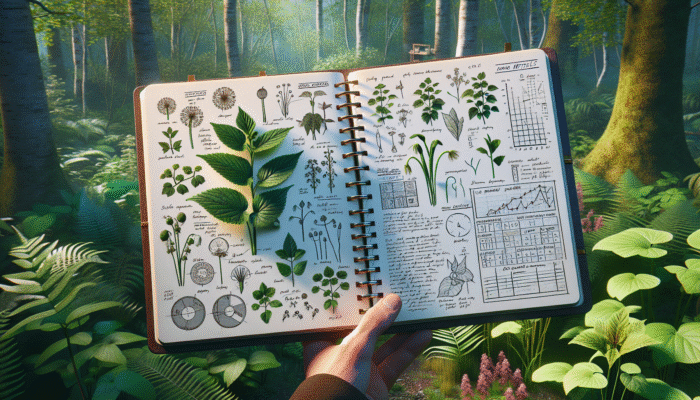Enhance Your Foraging Skills: Identify Safe and Tasty Edible Plants for Memorable Outdoor Experiences
Engaging in the transformative practice of foraging not only establishes a meaningful bond with the natural world, but also greatly enriches your culinary skills and knowledge. The first and most essential step in this exciting journey is to accurately identify edible plants, which is crucial for ensuring your safety while exploring nature's abundant offerings. By familiarising yourself with the unique characteristics of safe flora, you empower yourself to forage confidently and skillfully, allowing you to discover a variety of flavours and health benefits that wild edibles provide. This expertise opens up a realm of culinary creativity, enabling you to integrate fresh, organic ingredients into your daily meals.
Leverage Trustworthy and Extensive Resources for Accurate Plant Identification

The cornerstone of safe and effective foraging is the use of reliable resources. Comprehensive field guides are indispensable tools for anyone keen on exploring the fascinating realm of wild edibles. It is essential to select guides that are specifically designed for your geographical area, as these will offer detailed information on local plant species and their distinct features. Alongside printed guides, online databases and mobile applications can function as efficient visual aids; however, they should be used in conjunction with printed materials to ensure accuracy. Engaging with botany experts or becoming a member of local foraging groups can provide you with invaluable insights and hands-on experience from seasoned foragers. These mentors can share their personal stories, practical strategies, and techniques that will significantly enhance your foraging prowess. Notably, organisations like the National Audubon Society and local agricultural extensions frequently offer plant identification workshops that can play a crucial role in your educational journey.
Focus on Distinct Plant Features to Ensure Safe Foraging Practices
A deep understanding of the specific characteristics of plants is essential for safe and effective foraging. Important features to observe include leaf shape, colour, and growth patterns. For example, the leaves of wild garlic are long and slender, while the leaves of lily of the valley, which may look similar, are highly toxic. It is crucial to pay attention to details such as the size and arrangement of leaves, the presence of flowers, and the overall growth habit of each plant. Additionally, monitoring seasonal variations is beneficial for accurate identification; many plants look strikingly different during their flowering phase compared to their vegetative stage. By honing your observational skills and cultivating a discerning eye for these attributes, you can significantly lower the chances of incorrectly consuming toxic look-alikes, thereby enriching your foraging experience.
Prioritise Caution: Always Avoid Unknown Plant Species During Foraging
As you embark on your foraging adventures, the guiding principle should always be, “When in doubt, do without.” If you are uncertain about a plant's edibility, it is best to avoid consuming it altogether. Numerous plants have toxic relatives that can result in severe health complications if ingested. For instance, the edible hemlock has a deadly counterpart known as poison hemlock, which is frequently mistaken for the former. By cultivating a thorough understanding of the local flora through diligent and careful identification methods, you can significantly reduce these risks. Establishing a habit of confirming plant identities through multiple trustworthy sources prior to consumption will ensure a safer and more enjoyable foraging experience, allowing you to fully savour the joys of nature's generous offerings.
Conduct Regular Seasonal Assessments to Determine Plant Edibility

Plants can display varying characteristics and levels of edibility depending on the season. Some species, such as stinging nettles, are only palatable during their early spring growth stage; as they mature, they may become fibrous and less desirable. Understanding the seasonal fluctuations in plant growth and edibility will guide you in selecting the best times for foraging. Keeping a meticulous journal of your foraging experiences throughout the seasons can help identify the optimal periods for future excursions. This practice will not only deepen your knowledge but also assist you in planning your foraging trips when specific plants are at their peak, ensuring both maximum enjoyment and safety during your adventures.
Perform Edibility Tests for New and Unfamiliar Plants
To safeguard your health when encountering unfamiliar plants, the universal edibility test can be an invaluable method for assessing their safety. Start by isolating a small portion of the plant and preparing it for consumption. Consume a small amount and wait a full 24 hours to monitor for any potential adverse reactions. If you experience no signs of nausea, swelling, or other symptoms, you can gradually increase the quantity consumed. Although this method is not foolproof, it helps to mitigate the risk of toxic reactions. Keep in mind that individual sensitivities can vary widely, so maintaining ongoing vigilance is crucial when trying new foraged foods to ensure a safe and pleasant experience.
Master the Preparation of Foraged Edibles for Optimal Safety and Enjoyment
Once you have successfully foraged for edible plants, it is essential to prepare them correctly to guarantee safety and maximise enjoyment. From cleaning and cooking to storing your food, each step plays a pivotal role in maintaining food quality and preventing potential health hazards associated with improper handling.
Thoroughly Clean Foraged Foods to Remove Contaminants

The very first step in preparing foraged foods is thorough cleaning. Wild plants can often contain dirt, insects, and other potential contaminants that could impact your health. Rinse your foraged items under running water, using a soft brush for those with crevices where dirt may be hidden. For leafy greens such as dandelion greens, soaking them in cool water can effectively dislodge any grit. Furthermore, it is prudent to examine each item for any signs of mould or pests that could compromise their safety. Starting with a clean slate not only elevates the taste of your foraged foods but also diminishes the risk of foodborne illness, ensuring a delightful and healthy dining experience.
Cook Wild Edibles to Ensure Safety and Enhance Flavour
Certain wild edibles require cooking to neutralise toxins or improve digestibility. For example, cooking fiddlehead ferns and morel mushrooms is crucial, as they may contain harmful compounds when consumed raw. Familiarise yourself with recipes that are tailored to the plants you forage; this knowledge will not only secure your safety but also unlock the best flavours in your ingredients. Utilising cooking methods such as steaming or sautéing can transform your foraged finds into delectable dishes that are both nutritious and delicious. Moreover, cooking can enhance the bioavailability of certain nutrients, thereby maximising the health benefits of your harvest.
Implement Safe Storage Techniques for Fresh Foraged Foods
Proper storage of foraged foods is vital for maintaining their freshness and preventing spoilage. Many wild edibles are highly perishable and require refrigeration to prolong their shelf life. Storing herbs in a glass of water or wrapping them in a damp cloth can help keep them fresh for extended periods. For longer-term preservation, consider employing techniques such as drying or freezing. Dehydrating herbs, fruits, and vegetables not only preserves them but also intensifies their flavours, making them more enjoyable in future dishes. Always label your stored items with the date to help keep track of their freshness and ensure optimal use in your culinary creations.
Recognise Potential Allergies Related to Foraging for Enhanced Safety
As with any new food, understanding potential allergies is imperative when foraging. Recognising common allergens and knowing how to test for adverse reactions can significantly enhance your safety while exploring new wild edibles and incorporating them into your diet.
Identify and Avoid Common Food Allergens While Foraging
When foraging, it is essential to be aware of common food allergens. Nuts, berries, and certain plants can trigger allergic reactions in sensitive individuals. For example, while chestnuts are a delicious wild delicacy, they can pose a severe risk for anyone with a nut allergy. Conducting thorough research on potential allergens present in your region is crucial, particularly before introducing new foods into your diet. Familiarising yourself with local edibles and their potential allergenic properties can help you navigate potential pitfalls while safely expanding your culinary horizons.
Test New Foraged Foods in Small Quantities to Monitor Reactions
When incorporating new foraged foods into your diet, it is wise to approach with caution. Start by consuming small amounts of any unfamiliar plant to monitor for possible allergic responses. For instance, if you are trying wild blueberries for the first time, begin with just a few to assess your body's reaction before indulging in larger quantities. Keeping a detailed record of your experiences in a foraging journal can help you track what you enjoy and what may lead to discomfort. This practice not only enriches your foraging experience but also aids in preventing future allergic reactions, ensuring a safe and enjoyable journey through nature's offerings.
Consult a Medical Professional for Allergy Concerns When Foraging
If you have any concerns regarding allergies or reactions to foraged foods, seeking advice from a healthcare professional can provide clarity and peace of mind. An allergist can conduct tests to identify specific sensitivities and offer tailored guidance to help you navigate your foraging experiences safely. Moreover, if you experience severe reactions, it is crucial to seek medical attention promptly. Understanding your body's responses to new foods empowers you to forage safely and enjoyably, with confidence in your choices and in the natural world surrounding you.
Champion Environmental Respect and Sustainability in Your Foraging Practices
Foraging is not merely about gathering food; it also involves respecting the environment that sustains it. Adopting sustainable practices ensures that ecosystems remain healthy and vibrant for future generations, allowing everyone to enjoy nature's abundant offerings.
Embrace Sustainable Harvesting Practices for Long-Term Ecological Balance
Sustainable harvesting practices are essential for responsible foraging. Only take what you need and avoid depleting areas of their natural resources. For instance, when foraging for wild asparagus, ensure you leave enough behind to support future growth and regeneration. This approach not only helps to maintain healthy plant populations but also promotes biodiversity within the ecosystem. By cultivating a mindset centred on sustainability, you ensure that your foraging adventures positively impact the environment rather than contributing to its depletion, thereby preserving nature's beauty for generations to come.
Minimise Your Ecological Footprint While Foraging to Protect Natural Habitats
As you forage, it is crucial to be mindful of your surroundings and the delicate balance of the ecosystem. Avoid trampling fragile vegetation and strive to minimise disturbances to wildlife habitats. Whenever possible, stick to established trails, and consider using tools that lessen your ecological impact, such as biodegradable containers. Respecting natural habitats is vital for preserving biodiversity, which is essential for the overall health of ecosystems. By engaging with nature in a respectful manner, you can cultivate a symbiotic relationship that enables both foragers and the environment to flourish together.
Adhere to Local Foraging Regulations to Promote Sustainable Practices
Complying with local foraging laws and guidelines is vital for protecting both natural resources and your safety. Different regions have specific regulations concerning foraging times, locations, and allowable quantities of wild edibles. Conduct thorough research on local ordinances before embarking on your foraging adventures, as this knowledge can help you avoid fines and contribute to the conservation of native species. Engaging with the community regarding foraging regulations fosters a culture of respect and responsibility among fellow enthusiasts, ensuring the sustainability of these practices for future foragers.
Equip Yourself with the Right Foraging Tools for a Successful Experience
Having the appropriate tools at your disposal can greatly enhance your foraging experience, making it safer and more efficient. From gathering to storing your finds, the right gear plays a crucial role in ensuring successful foraging adventures.
Carry Essential Foraging Equipment to Enhance Efficiency and Safety
When foraging, it is essential to carry the necessary equipment that can streamline the process and improve your safety. A sturdy basket is ideal for collecting items, as it promotes proper air circulation, preventing spoilage of your finds. A sharp knife is invaluable for cutting stems or roots, while gloves can shield your hands from thorny plants or potential irritants. Investing in a high-quality field guide is also crucial to assist in plant identification while on the move. Additionally, carrying a small first aid kit can provide peace of mind while exploring the great outdoors, ensuring you are prepared for any minor injuries or issues that may arise.
Maintain Your Foraging Tools for Optimal Performance and Safety
Keeping your foraging equipment in excellent condition is fundamental for both safety and efficiency. Regularly clean your tools to prevent contamination and rust; this is particularly important for knives and containers that come into contact with food. Sharp tools enhance safety by reducing the likelihood of accidents while foraging, while well-maintained equipment ensures that you can tackle any task efficiently. Moreover, inspecting your gear before each outing ensures you are well-prepared for whatever challenges the day may present. Proper maintenance of your equipment not only enhances your foraging experience but also extends the lifespan of your tools, allowing you to forage effectively for years to come.
Select Appropriate Containers for Storing Foraged Foods to Maintain Freshness
Choosing the right containers for storing your foraged goods is crucial for maintaining their quality and freshness. Breathable materials, such as woven baskets or cloth bags, allow moisture to escape, thus preventing spoilage. It is advisable to avoid plastic bags, as they can trap moisture and lead to mould growth that can ruin your hard-earned finds. If you plan to store wet items, consider using breathable mesh bags or paper to keep them safe. Clearly labelling your containers with the date and contents will help you stay organised and ensure your foraged items remain fresh for use in your culinary creations.
Learn from Experienced Foragers to Enhance Your Skills and Knowledge
Foraging is an art form that benefits immensely from shared knowledge and expertise. Learning from seasoned foragers can accelerate your understanding and improve safety during your foraging adventures, deepening your connection with nature.
Join Local Foraging Groups for Community Learning and Support
Connecting with experienced foragers can provide invaluable insights into best practices and safety tips. Many local communities host foraging clubs or online forums where enthusiasts can share their knowledge and experiences. Participating in group foraging excursions allows for real-time learning, enabling you to ask questions and gain firsthand insights from others. Building relationships within these communities fosters a supportive environment, exponentially enhancing your foraging skills and confidence as you navigate the natural world.
Participate in Foraging Workshops for Hands-On Practical Experience
Foraging workshops offer hands-on experiences that can deepen your understanding of wild edibles and their uses. Many botanical gardens, nature reserves, and local agricultural extensions host workshops that cover plant identification, preparation, and sustainable harvesting techniques. Engaging in these educational settings allows you to practise in a structured environment under the guidance of experts. Not only do you learn about local plants in detail, but you also gain the confidence to forage safely and effectively, enriching your overall experience in the field.
Expand Your Knowledge Through Educational Foraging Materials and Resources
Delving into books and articles authored by foraging experts can significantly broaden your knowledge base. Resources such as “The Forager's Harvest” by Samuel Thayer offer comprehensive insights into specific plants, including their identification, preparation, and cultural significance. Furthermore, online articles and blogs provide current trends, recipes, and personal anecdotes that can inspire your foraging journey. Dedicating time to study various materials will adequately prepare you for a successful and safe foraging experience, empowering you to embrace the joys of gathering food from nature.
Stay Informed About Potential Contaminants While Foraging for Your Safety
While foraging opens a world of culinary possibilities, it is vital to remain aware of potential contaminants that could jeopardise your health. Understanding where to forage and what to avoid is key to ensuring safety during your foraging excursions and enjoying the fruits of your labour.
Avoid Foraging in Polluted Areas to Safeguard Your Health
Foraging in polluted areas can expose you to harmful toxins and contaminants that can adversely affect your health. Always steer clear of locations near busy roads, industrial sites, or agricultural fields where pesticides are likely to be used. Urban areas can also pose risks due to potential contamination from human activities. Instead, opt for pristine settings, such as untouched forests or natural reserves, to minimise exposure to pollutants. Researching local areas will help you identify safe foraging spots, ensuring that your finds remain healthy and safe for consumption, allowing you to enjoy nature's gifts without apprehension.
Exercise Caution Regarding Pesticide Residues on Foraged Plants for Your Safety
If you are foraging near agricultural zones, exercise caution concerning plants that may have been treated with pesticides or herbicides. These chemicals can linger on plants and pose significant health risks when ingested, potentially leading to serious health complications. Always inquire about local farming practices or seek out areas where organic farming is practised for safer foraging options. Thoroughly washing your foraged items can help eliminate surface residues, but understanding the source of your food is equally vital for your safety and well-being.
Monitor for Heavy Metals in Foraged Plants to Safeguard Your Health
Certain plants can absorb heavy metals from the soil, which can accumulate and pose health risks over time. Species such as wild spinach or purslane may absorb lead or cadmium if grown in contaminated soils. If you suspect that your foraging area may be polluted, consider having your finds tested for heavy metal concentrations. Being informed about the environmental conditions where you are foraging can help you make safer choices and avoid potential contamination, ensuring that your foraging experiences remain enjoyable and healthy.
Be Prepared for Emergencies While Foraging to Ensure a Safe Experience
While foraging, having a comprehensive plan for emergencies can provide an extra layer of reassurance and safety. Accidents and unexpected situations can arise, so being adequately prepared is paramount for a secure experience in the wild.
Always Carry a Well-Stocked First Aid Kit for Outdoor Safety
A well-stocked first aid kit is essential for any foraging trip. Basic supplies such as band-aids, antiseptic wipes, gauze, and adhesive tape can assist in treating minor injuries or allergic reactions that may occur while you are out in nature. Including items like antihistamines for allergic reactions and a snakebite kit can further enhance your preparedness for any unexpected situations. Regularly check and replenish your kit to ensure that all items remain current and usable, providing peace of mind during your outdoor adventures.
Acquire Basic First Aid Skills for Increased Safety While Foraging
Acquiring basic first aid skills can be invaluable during foraging excursions. Knowing how to perform CPR, treat wounds, or recognise signs of a stroke or heart attack can save lives in emergencies. Many organisations offer first aid courses that can equip you with these essential skills; this knowledge applies not only to foraging but also to everyday life. Being prepared with such knowledge enables you to respond effectively to various situations, ensuring a safer outdoor experience while you connect with nature.
Establish a Comprehensive Emergency Plan for Foraging Adventures
Developing a family emergency plan is crucial for any outdoor activity, including foraging. This plan should encompass communication strategies, evacuation routes, and designated meeting points to ensure everyone's safety. Familiarise yourself with the area where you will be foraging, and establish a timeframe for your outing to ensure a safe return. Sharing these details with family or friends adds an extra layer of security, allowing them to check on you if necessary, ensuring your well-being during your adventures in nature.
Frequently Asked Questions About Responsible Foraging Practices
What are the top resources for accurately identifying edible plants?
Reliable field guides and expert consultations are your best resources for identifying edible plants. Local foraging groups and online databases can also provide valuable information and insights that enhance your foraging experiences.
How can I determine if a plant is safe for consumption?
Always confirm plant identities through multiple reliable sources, carefully observe their characteristics, and if you’re uncertain, refrain from consuming them to ensure your safety.
What should I do if I suspect I have consumed a toxic plant?
Seek immediate medical attention. If possible, bring a sample of the plant with you to assist healthcare professionals with identification and treatment.
Are there any plants I should avoid foraging?
Yes, avoid foraging near polluted areas or those treated with pesticides. Additionally, steer clear of species that are known to have toxic relatives to ensure your safety and well-being.
How do I store foraged plants safely to maintain freshness?
Store foraged plants in breathable containers, such as baskets or cloth bags, to maintain quality and prevent spoilage. Refrigeration may be necessary to prolong the freshness of highly perishable items.
Can I forage in urban areas without concerns about safety?
Yes, however, be cautious of pollution and chemicals. Look for parks or natural areas that are less likely to be contaminated for safer foraging opportunities.
What common allergens should I be aware of while foraging?
Common allergens include nuts, berries, and certain wild plants. Always research potential allergens before introducing new foraged foods into your diet to avoid allergic reactions.
How can I participate in foraging workshops for practical learning?
Check with local agricultural extension offices, botanical gardens, or foraging groups for information on upcoming workshops and events that offer educational opportunities for aspiring foragers.
What is the universal edibility test, and how does it work?
The universal edibility test involves consuming a small portion of a new plant and waiting 24 hours to monitor for any adverse reactions before deciding to eat more of it.
Is foraging legal everywhere, and what should I know?
No, foraging laws vary by region. Always check local regulations and obtain permission if foraging in private areas to avoid legal issues and ensure responsible practices.
Explore our world on X!
The post Foraging Safety Tips: Essential Guidelines appeared first on Survival Bite.
The Article Foraging Safety Tips: Key Guidelines for Safe Harvesting Was Found On https://limitsofstrategy.com


Engaging in the practice of foraging is like a scavenger hunt for adults, where the prizes are not just shiny rocks or dubious-looking beads, but actual delicious ingredients that could potentially elevate your dinner from “meh” to “mouth-wateringly memorable.” I remember my first attempt at foraging, where I confidently plucked what I believed to be a wild edible herb, only to discover later that I had mistook it for something that should be labeled “not edible, and also maybe poisonous.” It was a moment of great humility, let me tell you!
Your experience perfectly captures one of the most profound lessons in foraging: it’s all about the journey, not just the destination. That moment of sheer confidence followed by a humbling realization is a rite of passage for many who venture into the wild to gather what nature offers. It’s a reminder of how intricately connected we are to our environment and how little we might actually know about it.
“Ah, the thrill and uncertainty of foraging! If you want to avoid those ‘oops’ moments and truly enhance your culinary adventures, check out this guide to safe and delicious wild edibles!”
https://aslicklook.co.uk/ParentAler
Your experience perfectly captures one of the most profound lessons in foraging: it’s all about the journey, not just the destination. That moment of sheer confidence followed by a humbling realization is a rite of passage for many who venture into the wild to gather what nature offers. It’s a reminder of how intricately connected we are to our environment and how little we might actually know about it.
“Ah, the thrill and uncertainty of foraging! If you want to avoid those ‘oops’ moments and truly enhance your culinary adventures, check out this guide to safe and delicious wild edibles!”
https://aslicklook.co.uk/ParentAler
You’ve hit the nail on the head with that “thrill of the hunt” vibe. Foraging can feel like a treasure hunt where the prize is usually, well, edible—unless you misidentify something and end up on a plant adventure that involves lots of regretful bathroom trips. It’s a bit like a wild culinary roulette!
Your experience perfectly captures the thrill and caution that come with foraging. It really is adventurous—there’s something exhilarating about connecting directly with nature and bringing home fresh ingredients. But as you’ve noted, the risk of misidentifying plants adds a significant layer of complexity.
Your experience perfectly captures the thrill and risks of foraging. It’s true that finding wild ingredients can feel like a scavenger hunt, and it can be quite the journey—both delicious and sometimes slightly harrowing! That mix of excitement and caution is part of what makes foraging so captivating.